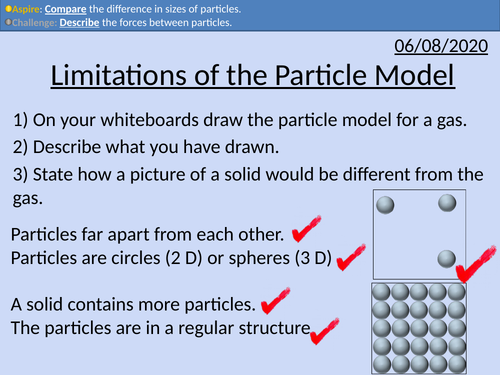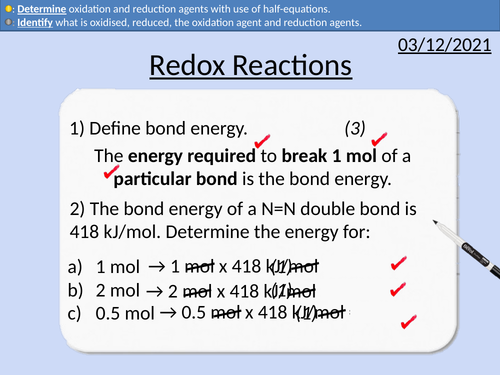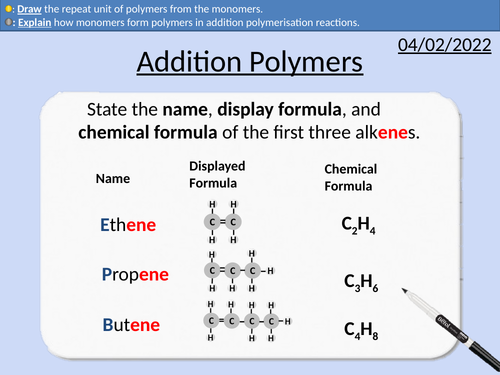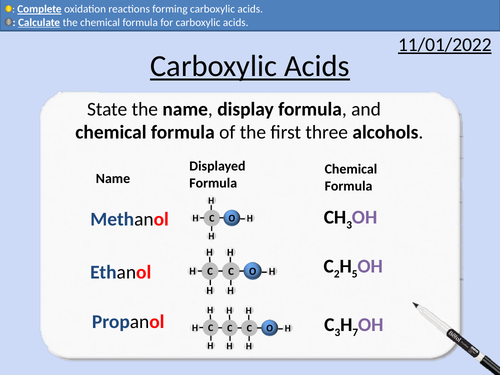496Uploads
162k+Views
70k+Downloads
All resources
Bundle

OCR A level Physics: Ideal Gas
OCR A level Physics: Ideal Gas is a part of the Module 5: Newtonian World and Astrophysics.
All presentations come with worked examples, solutions and homeworks.
Bundle

OCR A level Physics: Particle Physics
OCR A level Physics: Chapter 24 Particle Physics is apart of the Module 6: Particle and Medical Physics
All presentations come with worked examples, solutions and homeworks.
24.1 Alpha-particle scattering experiment
24.2 The Nucleus
24.3 Antiparticles, Leptons, & Hadrons
24.4 Quarks
24.5 Beta decay
Developments of scientific models
Thompson’s plum-pudding model
Rutherford’s nuclear (planetary) model
Rutherford’s experiment, observations, and conclusions
Using Coulomb’s law to find the minimum distance between particles
Nucleons
Isotopes
Nuclear notation
Atomic mass units (u)
Radius for atomic nucleus equation
Volume and density of atomic nuclei
The strong nuclear force
Antiparticles, their properties, and symbols
Particle and antiparticle annihilation
The four fundamental forces (strong nuclear, weak nuclear, electromagnetic, and gravitational forces) and their properties.
Definition and examples of hadrons and leptons.
The Standard Model of particle physics
Quarks, anti-quarks and their charges
Baryons and mesons
Properties of neutrinos
Nuclear notation
Nuclear decay equations
Beta-plus and beta-minus decays
Quark transformation

OCR AS Chemistry: Chemical Reactions of Alkanes
OCR AS Chemistry: 12.2 Chemical Reactions of Alkanes
This PowerPoint is a whole lessons included with student activities, animated answers, homework questions with answers provided.
This lesson covers:
Combustion reactions
Incomplete combustion reactions
Balancing equations
Using algebraic equations
Radical substitution reactions
Reaction mechanism for haloalkanes - Initiation, Propagation, and Termination
Monosubstituted (positional isomers) isomers
Bundle

OCR A level Physics: Radioactivity
OCR A level Physics: Chapter 25 Radioactivity is apart of the Module 6: Particle and Medical Physics
All presentations come with worked examples, solutions and homeworks.
25.1 Radioactivity
25.2 Nuclear decay equations
25.3 Half-life and Activity
25.4 Radioactive Decay Calculations
25.5 Modelling Radioactive Decay
25.6 Radioactive Dating
Types of ionising radiation (alpha, beta-plus/beta-minus, gamma)
Penetration power and ionising power
Detecting radiation with a Geiger (GM tube) counter
Background radiation and correct count rates
Electric and magnetic fields affect ionising radiation
Cloud chambers
Typical speeds of radiation produced form nuclear decays
Conservation rules for nuclear decays
Nuclear notation
Alpha decays
Beta-minus and beat-plus decays
Gamma decays
Decay chains
The reason why radioactive decays are considered random and spontaneous
Rolling dice being a good analogue for radioactive decays
Definition of half-life
Determining half-life from a graph.
Calculating half-life from a table of data.
Activity of a sample in Bq
The decay constant derivation
Decay constant and half-life
Using exponentials to calculate activity and number of nuclei present
Solving Differential Equations (beyond A-level Physics course)
Iterative Method
Selecting appropriate time intervals
Comparing answers from the iterative method and exact solution.
State what isotopes of carbon are used in carbon dating.
Explain how carbon dating works.
Calculate the age of objects with carbon dating.

GCSE Chemistry: Limitations of the Particle Model
This PowerPoint presentation with worked examples and student questions covers:
• Describing the limitations of the model: lack of forces between particles, size of particles, and space between the particles.
• Mathematically comparing sizes and distances of particles

OCR AS Chemistry: Representing the formulae of Organic Compounds
OCR AS Chemistry: Formulae for Organic Compounds
This PowerPoint is a whole lessons included with student activities, animated answers, homework questions with answers provided.
This lesson covers:
molecular formula
empirical formula
general formula
displayed formula
structural formula
skeletal formula

OCR A level Physics: Electric Potential and Energy
OCR A level Physics: 22.5 Electric Potential and Energy
Module 6 Particles and Medical Physics
This PowerPoint is a whole lesson included with student activities, animated answers, homework questions with answers provided.
This lesson covers:
Definition of electric potential energy
Definition of electric potential.
Definition of electric potential difference.
Using a force-distance graph to determine electric potential energy
Using electron-volts and joules in calculations
Capacitance of an isolated charged sphere

OCR A level Physics: Alpha-particle Scattering Experiment
OCR A level Physics: 24.1 Alpha-particle Scattering Experiment
Module 6 Particles and Medical Physics
This PowerPoint is a whole lesson included with student activities, animated answers, homework questions with answers provided.
This lesson covers:
Developments of scientific models
Thompson’s plum-pudding model
Rutherford’s nuclear (planetary) model
Rutherford’s experiment, observations, and conclusions
Using Coulomb’s law to find the minimum distance between particles
Bundle

OCR AS level Physics: Waves 1
OCR AS level Physics presentations for module 4: Waves 1
All presentations come with worked examples, solutions and homeworks.
This covers topics from wave properties to Snell’s law and total internal reflection.

GCSE Chemistry: Redox Reactions
This PowerPoint presentation with worked examples and student questions covers:
• Oxidation and reduction reactions for oxygen
• Identification of oxidation and reduction agents
• Oxidation and reduction reactions for electrons
• Half equations to determine oxidation and reduction

GCSE Chemistry: Addition Polymers
This PowerPoint presentation with worked examples and student questions covers:
Prefixes mono- and poly-
Alkanes and alkenes functional groups
Saturated and unsaturated carbon bonds
Addition polymerisation reactions
Conditions needed for polymerisation reactions
How monomers form polymers
Repeat units and monomers
Bundle

OCR A level Physics: Oscillations and Simple Harmonic Motion
OCR A level Physics: Oscillations and Simple Harmonic Motion is a part of the Module 5: Newtonian World and Astrophysics.
All presentations come with worked examples, solutions and homeworks.
Bundle

OCR A level Chemistry: Aromatic Compounds
OCR A level Chemistry: Aromatic Compounds is apart of the Module 6: Organic Chemistry and Analysis.
All presentations come with worked examples, solutions and homeworks
Molecular, empirical, skeletal formula for benzene.
The Kekulé model for benzene
Evidence against the Kekule model
The delocalised model for benzene
Nomenclature for benzene rings and aromatic (arene) compounds
Naming benzene containing compounds
Drawing benzene containing compounds
Defining an electrophile
Substitution reactions
Nitration of Benzene
Reaction mechanisms
Halogenation of Benzene
Common Halogen Carriers
Friedel-Crafts Alkylation Reactions
Acyl Chloride
Acylation Reactions of Benzene
Reactivity of Alkenes and Arenes
Naming phenols
Distinguishing between phenols and alcohols
Distinguishing between phenols and alkenes
Distinguishing between phenols and carboxylic acids
Phenol as a weak acid
Electrophilic reactions with phenols
Comparing and explaining the reactivity of phenols and benzene
Naming positions on the aromatic ring
Activating groups and deactivating groups
2-and-4-directing and 3-directing groups
ortho-and-para directing and meta directing groups
Two-step synthesis routes for benzene using directing groups.
Nitration of benzene
Halogenation of benzene
Friedel-Crafts Alkylation of benzene

GCSE Chemistry: Carboxylic Acids
This PowerPoint presentation with worked examples and student questions covers:
• Functional groups of carboxylic acids, alcohols, alkanes, and alkenes.
• Mnemonic device for naming carboxylic acids
• General formula for carboxylic acids
• Drawing the structural formula for carboxylic acids
• Carboxylic acids as weak acids and
• Acid reactions with bases, metals, and carbonates
• Oxidation reactions from alcohols to carboxylic acids
Bundle

OCR AS level Physics: Motion
OCR AS level Physics: Forces and Motion is a part of the Module 3: Forces and Motion.
All presentations come with worked examples, solutions and homeworks.
These are fully updated PowerPoints will all exercises with full worked solutions.

OCR AS Chemistry: Polymerisation of Alkenes
OCR AS Chemistry: 13.5 Polymerisation of Alkenes
This PowerPoint is a whole lessons included with student activities, animated answers, homework questions with answers provided.
This lesson covers:
Monomers and repeat units
Addition Polymerisation for:
Polyethene
Polypropene
Polylactate
Polystyrene
Polyvinyl Chloride (PVC)
Environmental Concerns from polymers including:
Combustion of polymers
recycling PVC
biogradeable bioplastics
photodegradable polymers
feedstock recycling

A level Chemistry: Further Practical Techniques
OCR A level Chemistry: 28.2 Further Practical Techniques
This PowerPoint is a whole lesson included with student activities, animated answers, homework questions with answers provided.
This lesson covers:
Filtration under reduced pressure
Purification through Recrystallisation
Preparation of Melting Point Sample
Melting point determination with an electric heater
Melting point determination with a Thiele tube

OCR A level Physics: Objects in the Universe
OCR A level Physics: 19.1 Objects in the Universe
Module 5 Newtonian World and Astrophysics
This PowerPoint is a whole lesson included with student activities, animated answers, homework questions with answers provided.
This lesson covers:
The size of astronomical objects: Universe, Galaxies, Solar systems, Stars, Planets, Planetary satellites, Comets, Artificial planetary satellites
Comparing planets and comets
The birth of stars
Stars in equilibrium during the main sequence
Bundle

GCSE OCR Physics P4 Magnetism
All resources for P4 Magnetism and Magnetic Fields for GCSE OCR Physics Gateway 9-1.Triple and combined (Higher and Foundation) is covered in this material.
• Magnets and Magnetic Fields
• Currents and Fields
• Right Hand Cork-screw Rule
• Fleming’s Left Hand Rule
• Currents and Forces
• Motors
• Electromagnetic Induction
• Generators
• Transformers
• Speakers and Microphones
Bundle

OCR AS level Physics: Waves 2
OCR AS level Physics presentations for module 4: Waves 2
All presentations come with worked examples, solutions and homeworks.
This covers topics from Superposition of Waves to Harmonics with different boundary conditions.




















